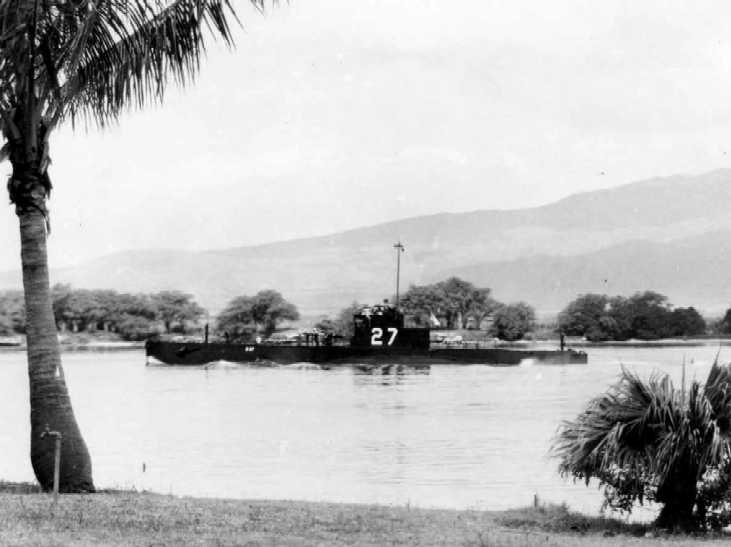
Based at New London through 1924, USS S-27 (SS-132) was transferred to the Pacific in 1925; and, after exercises in the Hawaiian Islands during the spring of that year, she arrived at her new homeport, San Diego, in June. She remained based in southern California through the decade and, except for fleet maneuvers, operated primarily off that coast. Fleet maneuvers, exercises, and problems took her to the west coast of Central America; to the Panama Canal Zone; into the Caribbean; and to Hawaii. In 1931, she was transferred to Hawaii; and, on 23 February, she arrived at Pearl Harbor, whence she operated until mid-1939. On 16 June 1939, she sailed east; and, on the 27th, she arrived at San Diego and resumed operations off the southern California coast.
For the next two and a half years, she conducted exercises and tests off that coast, primarily for the Underwater Sound Training School. In late November 1941, she proceeded to Mare Island, where she was undergoing overhaul when the United States entered WWII.
On 23 January 1942, S-27 stood out of San Francisco Bay and moved south. Three days later, she returned to San Diego and resumed operations for the Sound School which she continued into the spring. Then ordered north, to the Aleutians, she departed San Diego on 20 May; steamed to Port Angeles; thence, continued on to Alaskan waters where she commenced patrol operations in June. On the 12th, a little over a week after beginning of the war in the Aleutians, she put into Dutch Harbor, took on provisions, refueled, and then headed west with orders to patrol in the Kuluk Bay area and to reconnoiter Constantine Harbor, Amchitka. On the 18th, having found no signs of enemy activity in the evacuated village of the harbor, she moved on to round the southern end of the island,whence she would proceed to Kiska. In mid-afternoon, she rounded East Cape and that night when she surfaced, fog obscured her position. Lying to to charge her badly depleted batteries on two engines after running submerged during the very long Aleutian "day," she was carried about five miles from her estimated (DR) position. The fog prevented knowledge of the drift. At midnight she got underway, slowly, on one engine and continued to charge on the other. Soon after 0043 on the 19th, breakers were sighted about 25 yards forward of the bow. "Back Emergency" orders were given. Seconds later, S-27 grounded on rocks off St. Makarius Point.
Waves bumped her violently against the rocks, rolling her 10 to 15 degrees on each side. Her motors were continued at "back emergency," but she was held firm by a submerged rock. Fuel was blown. Efforts to back off were continued, but the lightened ship swung harder against the rocks. Her starboard screw struck a rock and was disabled.
Efforts were made to force the ship ahead to clear the stern; but, she could move only about twenty feet forward before she was again held fast. The immediate area was sounded. No passage was found. The seas continued to pound her.
By 0330, the pounding had increased and plans were made to move the greater part of the crew off. Dispatches of her plight, sent first at 0115, were continued. Six were sent it all. One, giving no position, was received at Dutch Harbor.
A ferry system, using a rubber boat and lines rigged between the ship and the beach, was set up. Men, provisions, clothing, guns, and medical supplies were transferred safely. By 1100, all but six, the commanding officer and five others, were ashore. All equipment was destroyed. Classified material was burned. At 1530, three of the remaining men went ashore. The side plating was now loose; the torpedo room was flooding. At 1550, the radioman, executive officer, and commanding officer left the submarine.
The night of 19-20 June was spent in an unsheltered cove. On the 20th, camp was set up at Constantine Harbor, using the buildings and heating equipment which had survived a Japanese bombing. By the 21st, the camp was fully organized; routines, including sentries and lookouts, had been established. Trips to and from the cove continued for three days. S-27 was reboarded on the 21st and 22nd; thereafter, the presence of chlorine gas prohibited further visits to take off more supplies.
On the 24th, a PBY on a routine flight spotted the activity at Constantine
Harbor; landed; and took off 15 of the survivors. On the 25th, three planes
were sent in to bring off the remainder. All guns salvaged from S-27
were destroyed. Nothing was left except the submarine's hulk and canned
provisions, blankets, and winter clothing. No member of the crew was lost
during the disaster.